Taxation Law of Australia: Individual Assignment, Term 2, 2019
VerifiedAdded on 2022/10/02
|8
|2114
|468
Homework Assignment
AI Summary
This assignment solution addresses various aspects of Australian taxation law. It begins by clarifying several taxation principles and rules, including the concept of continuing a business activity, contributions and gifts for deduction, the highest tax rate for resident individual taxpayers, and exempt...
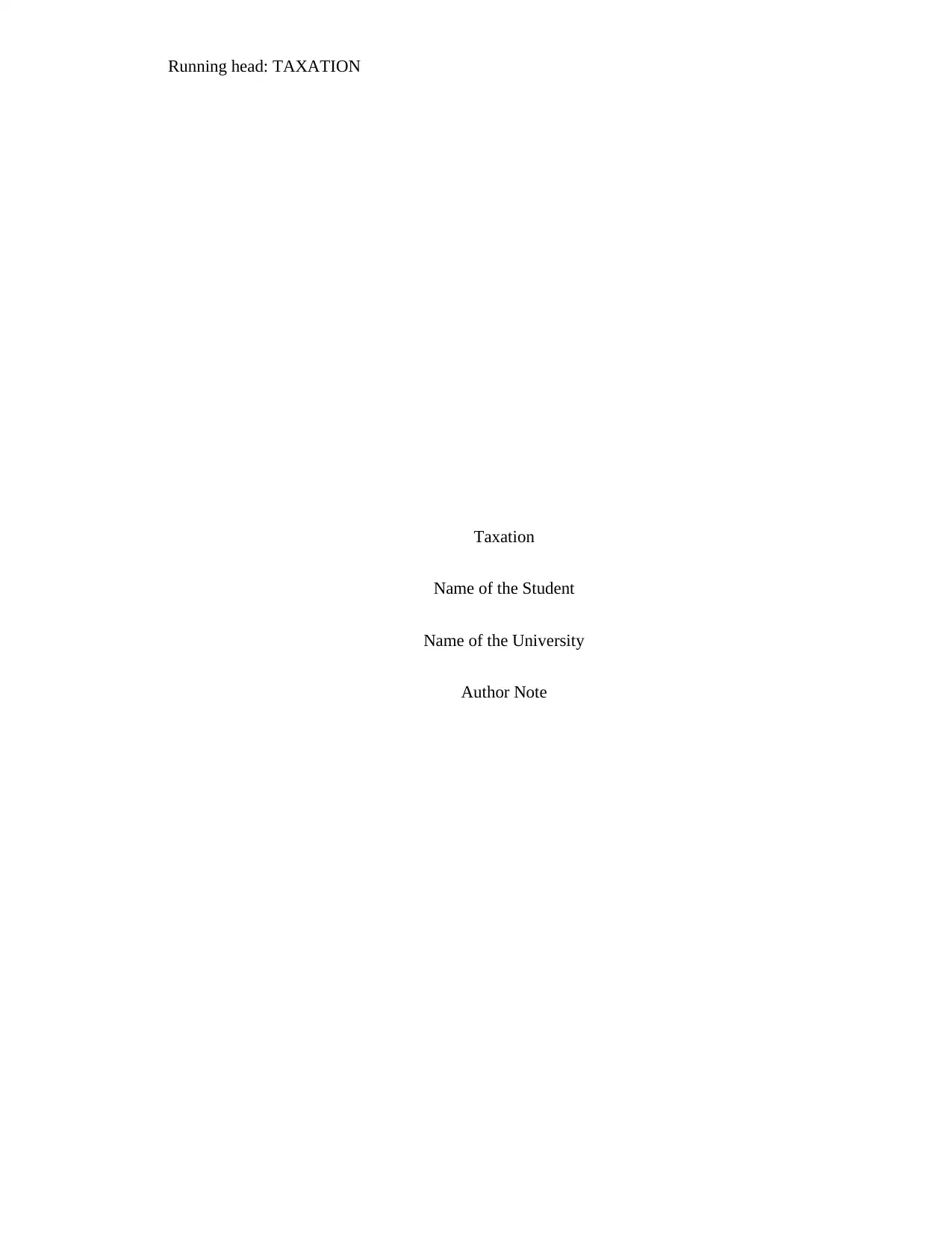
Running head: TAXATION
Taxation
Name of the Student
Name of the University
Author Note
Taxation
Name of the Student
Name of the University
Author Note
Paraphrase This Document
Need a fresh take? Get an instant paraphrase of this document with our AI Paraphraser
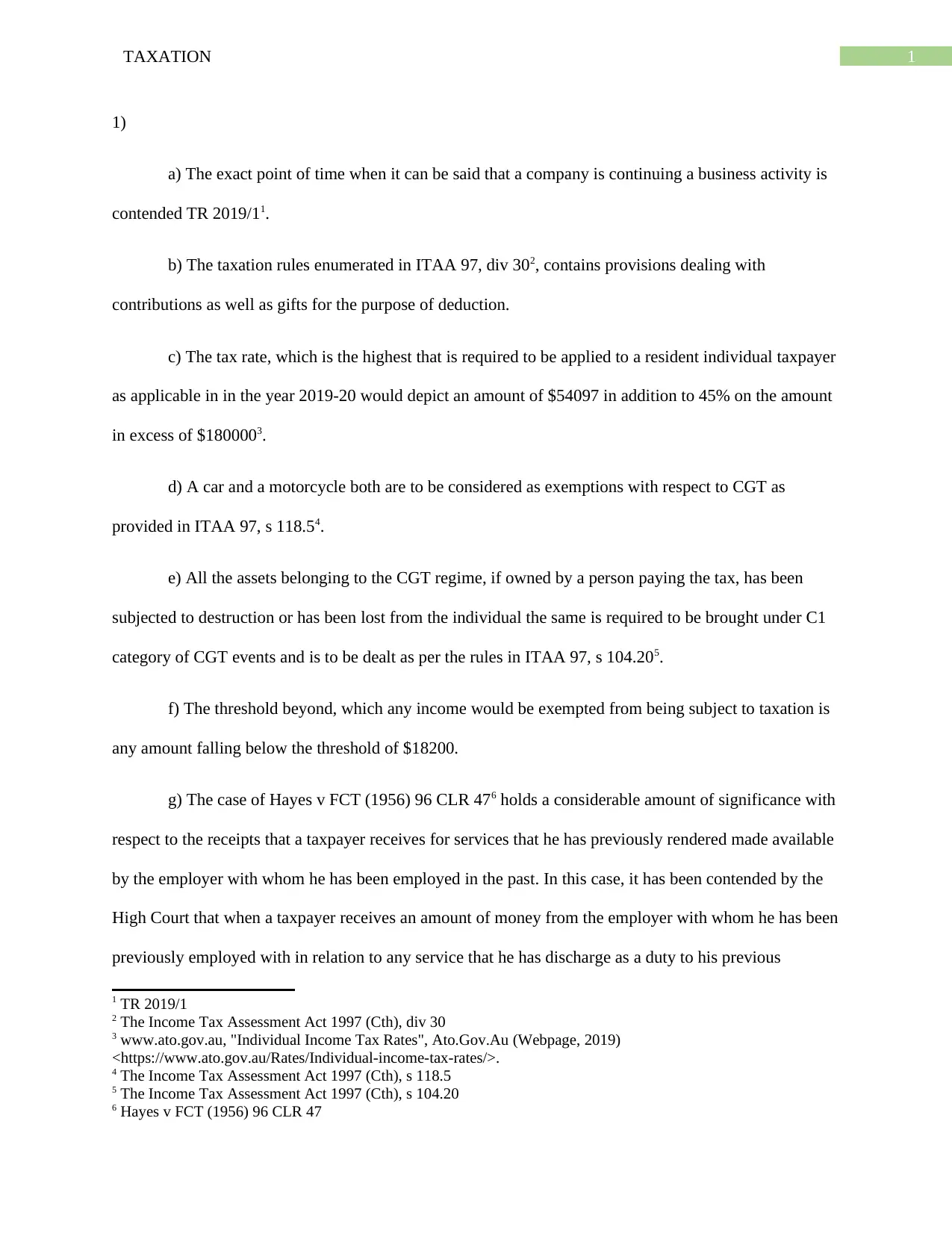
1TAXATION
1)
a) The exact point of time when it can be said that a company is continuing a business activity is
contended TR 2019/11.
b) The taxation rules enumerated in ITAA 97, div 302, contains provisions dealing with
contributions as well as gifts for the purpose of deduction.
c) The tax rate, which is the highest that is required to be applied to a resident individual taxpayer
as applicable in in the year 2019-20 would depict an amount of $54097 in addition to 45% on the amount
in excess of $1800003.
d) A car and a motorcycle both are to be considered as exemptions with respect to CGT as
provided in ITAA 97, s 118.54.
e) All the assets belonging to the CGT regime, if owned by a person paying the tax, has been
subjected to destruction or has been lost from the individual the same is required to be brought under C1
category of CGT events and is to be dealt as per the rules in ITAA 97, s 104.205.
f) The threshold beyond, which any income would be exempted from being subject to taxation is
any amount falling below the threshold of $18200.
g) The case of Hayes v FCT (1956) 96 CLR 476 holds a considerable amount of significance with
respect to the receipts that a taxpayer receives for services that he has previously rendered made available
by the employer with whom he has been employed in the past. In this case, it has been contended by the
High Court that when a taxpayer receives an amount of money from the employer with whom he has been
previously employed with in relation to any service that he has discharge as a duty to his previous
1 TR 2019/1
2 The Income Tax Assessment Act 1997 (Cth), div 30
3 www.ato.gov.au, "Individual Income Tax Rates", Ato.Gov.Au (Webpage, 2019)
<https://www.ato.gov.au/Rates/Individual-income-tax-rates/>.
4 The Income Tax Assessment Act 1997 (Cth), s 118.5
5 The Income Tax Assessment Act 1997 (Cth), s 104.20
6 Hayes v FCT (1956) 96 CLR 47
1)
a) The exact point of time when it can be said that a company is continuing a business activity is
contended TR 2019/11.
b) The taxation rules enumerated in ITAA 97, div 302, contains provisions dealing with
contributions as well as gifts for the purpose of deduction.
c) The tax rate, which is the highest that is required to be applied to a resident individual taxpayer
as applicable in in the year 2019-20 would depict an amount of $54097 in addition to 45% on the amount
in excess of $1800003.
d) A car and a motorcycle both are to be considered as exemptions with respect to CGT as
provided in ITAA 97, s 118.54.
e) All the assets belonging to the CGT regime, if owned by a person paying the tax, has been
subjected to destruction or has been lost from the individual the same is required to be brought under C1
category of CGT events and is to be dealt as per the rules in ITAA 97, s 104.205.
f) The threshold beyond, which any income would be exempted from being subject to taxation is
any amount falling below the threshold of $18200.
g) The case of Hayes v FCT (1956) 96 CLR 476 holds a considerable amount of significance with
respect to the receipts that a taxpayer receives for services that he has previously rendered made available
by the employer with whom he has been employed in the past. In this case, it has been contended by the
High Court that when a taxpayer receives an amount of money from the employer with whom he has been
previously employed with in relation to any service that he has discharge as a duty to his previous
1 TR 2019/1
2 The Income Tax Assessment Act 1997 (Cth), div 30
3 www.ato.gov.au, "Individual Income Tax Rates", Ato.Gov.Au (Webpage, 2019)
<https://www.ato.gov.au/Rates/Individual-income-tax-rates/>.
4 The Income Tax Assessment Act 1997 (Cth), s 118.5
5 The Income Tax Assessment Act 1997 (Cth), s 104.20
6 Hayes v FCT (1956) 96 CLR 47
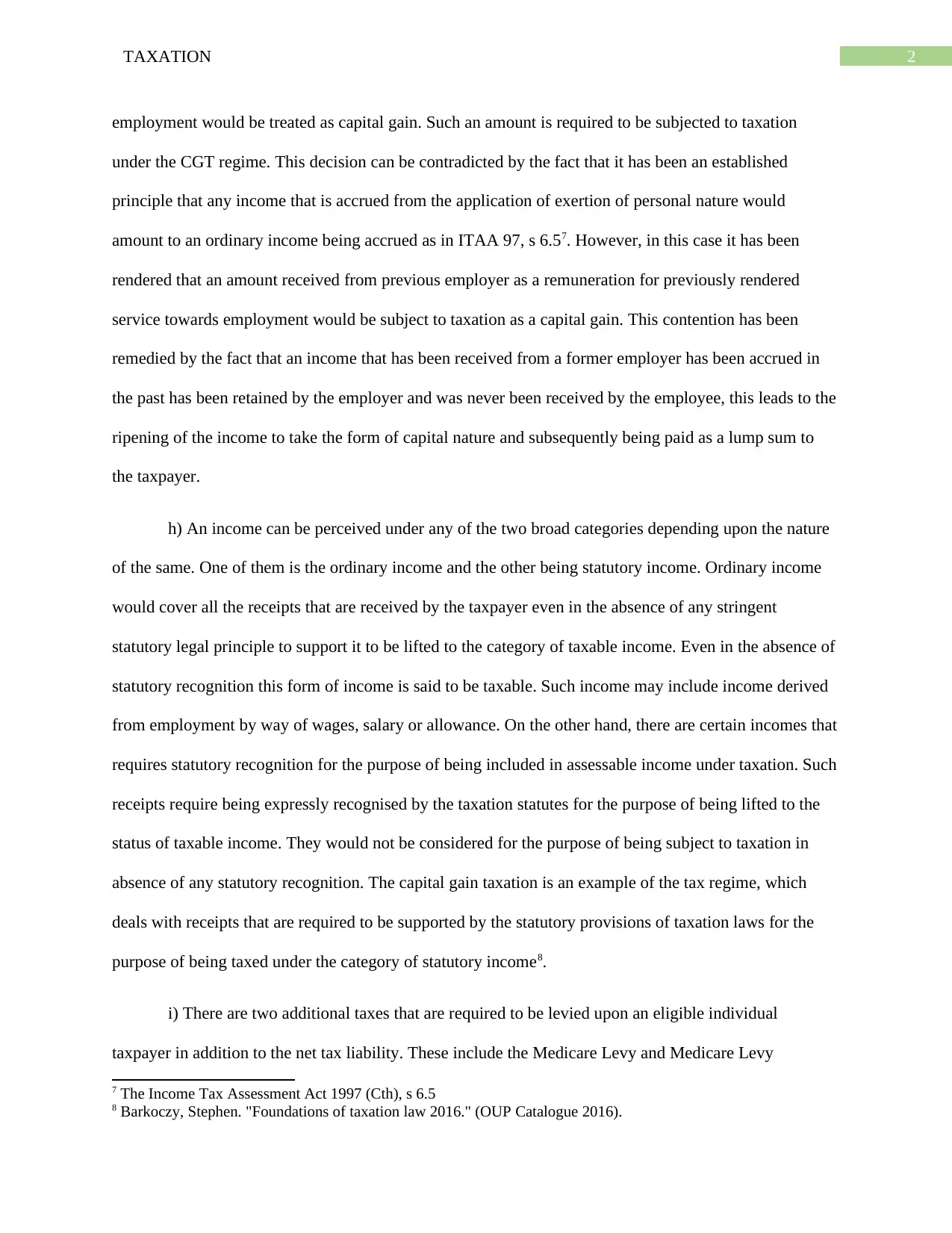
2TAXATION
employment would be treated as capital gain. Such an amount is required to be subjected to taxation
under the CGT regime. This decision can be contradicted by the fact that it has been an established
principle that any income that is accrued from the application of exertion of personal nature would
amount to an ordinary income being accrued as in ITAA 97, s 6.57. However, in this case it has been
rendered that an amount received from previous employer as a remuneration for previously rendered
service towards employment would be subject to taxation as a capital gain. This contention has been
remedied by the fact that an income that has been received from a former employer has been accrued in
the past has been retained by the employer and was never been received by the employee, this leads to the
ripening of the income to take the form of capital nature and subsequently being paid as a lump sum to
the taxpayer.
h) An income can be perceived under any of the two broad categories depending upon the nature
of the same. One of them is the ordinary income and the other being statutory income. Ordinary income
would cover all the receipts that are received by the taxpayer even in the absence of any stringent
statutory legal principle to support it to be lifted to the category of taxable income. Even in the absence of
statutory recognition this form of income is said to be taxable. Such income may include income derived
from employment by way of wages, salary or allowance. On the other hand, there are certain incomes that
requires statutory recognition for the purpose of being included in assessable income under taxation. Such
receipts require being expressly recognised by the taxation statutes for the purpose of being lifted to the
status of taxable income. They would not be considered for the purpose of being subject to taxation in
absence of any statutory recognition. The capital gain taxation is an example of the tax regime, which
deals with receipts that are required to be supported by the statutory provisions of taxation laws for the
purpose of being taxed under the category of statutory income8.
i) There are two additional taxes that are required to be levied upon an eligible individual
taxpayer in addition to the net tax liability. These include the Medicare Levy and Medicare Levy
7 The Income Tax Assessment Act 1997 (Cth), s 6.5
8 Barkoczy, Stephen. "Foundations of taxation law 2016." (OUP Catalogue 2016).
employment would be treated as capital gain. Such an amount is required to be subjected to taxation
under the CGT regime. This decision can be contradicted by the fact that it has been an established
principle that any income that is accrued from the application of exertion of personal nature would
amount to an ordinary income being accrued as in ITAA 97, s 6.57. However, in this case it has been
rendered that an amount received from previous employer as a remuneration for previously rendered
service towards employment would be subject to taxation as a capital gain. This contention has been
remedied by the fact that an income that has been received from a former employer has been accrued in
the past has been retained by the employer and was never been received by the employee, this leads to the
ripening of the income to take the form of capital nature and subsequently being paid as a lump sum to
the taxpayer.
h) An income can be perceived under any of the two broad categories depending upon the nature
of the same. One of them is the ordinary income and the other being statutory income. Ordinary income
would cover all the receipts that are received by the taxpayer even in the absence of any stringent
statutory legal principle to support it to be lifted to the category of taxable income. Even in the absence of
statutory recognition this form of income is said to be taxable. Such income may include income derived
from employment by way of wages, salary or allowance. On the other hand, there are certain incomes that
requires statutory recognition for the purpose of being included in assessable income under taxation. Such
receipts require being expressly recognised by the taxation statutes for the purpose of being lifted to the
status of taxable income. They would not be considered for the purpose of being subject to taxation in
absence of any statutory recognition. The capital gain taxation is an example of the tax regime, which
deals with receipts that are required to be supported by the statutory provisions of taxation laws for the
purpose of being taxed under the category of statutory income8.
i) There are two additional taxes that are required to be levied upon an eligible individual
taxpayer in addition to the net tax liability. These include the Medicare Levy and Medicare Levy
7 The Income Tax Assessment Act 1997 (Cth), s 6.5
8 Barkoczy, Stephen. "Foundations of taxation law 2016." (OUP Catalogue 2016).
You're viewing a preview
Unlock full access by subscribing today!
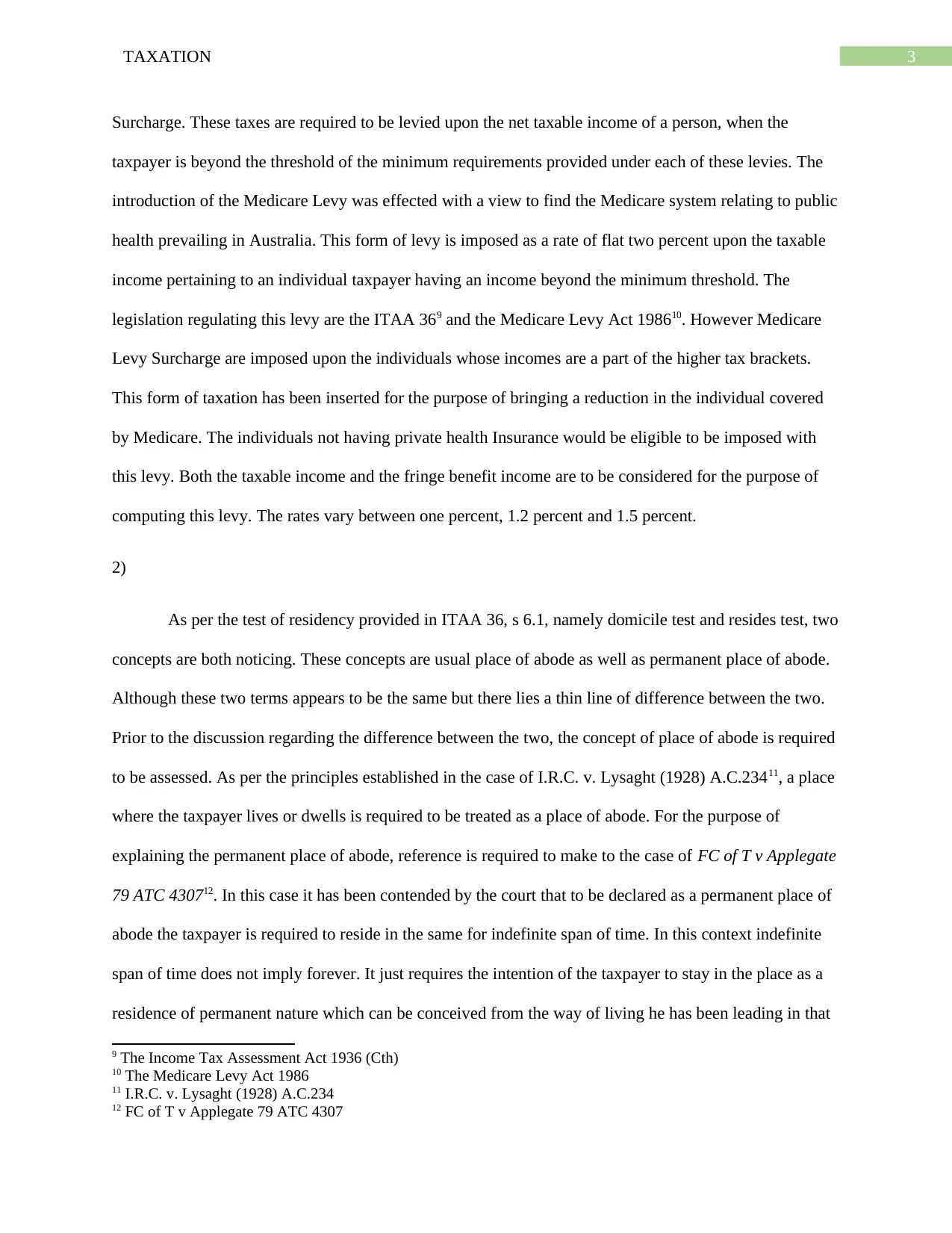
3TAXATION
Surcharge. These taxes are required to be levied upon the net taxable income of a person, when the
taxpayer is beyond the threshold of the minimum requirements provided under each of these levies. The
introduction of the Medicare Levy was effected with a view to find the Medicare system relating to public
health prevailing in Australia. This form of levy is imposed as a rate of flat two percent upon the taxable
income pertaining to an individual taxpayer having an income beyond the minimum threshold. The
legislation regulating this levy are the ITAA 369 and the Medicare Levy Act 198610. However Medicare
Levy Surcharge are imposed upon the individuals whose incomes are a part of the higher tax brackets.
This form of taxation has been inserted for the purpose of bringing a reduction in the individual covered
by Medicare. The individuals not having private health Insurance would be eligible to be imposed with
this levy. Both the taxable income and the fringe benefit income are to be considered for the purpose of
computing this levy. The rates vary between one percent, 1.2 percent and 1.5 percent.
2)
As per the test of residency provided in ITAA 36, s 6.1, namely domicile test and resides test, two
concepts are both noticing. These concepts are usual place of abode as well as permanent place of abode.
Although these two terms appears to be the same but there lies a thin line of difference between the two.
Prior to the discussion regarding the difference between the two, the concept of place of abode is required
to be assessed. As per the principles established in the case of I.R.C. v. Lysaght (1928) A.C.23411, a place
where the taxpayer lives or dwells is required to be treated as a place of abode. For the purpose of
explaining the permanent place of abode, reference is required to make to the case of FC of T v Applegate
79 ATC 430712. In this case it has been contended by the court that to be declared as a permanent place of
abode the taxpayer is required to reside in the same for indefinite span of time. In this context indefinite
span of time does not imply forever. It just requires the intention of the taxpayer to stay in the place as a
residence of permanent nature which can be conceived from the way of living he has been leading in that
9 The Income Tax Assessment Act 1936 (Cth)
10 The Medicare Levy Act 1986
11 I.R.C. v. Lysaght (1928) A.C.234
12 FC of T v Applegate 79 ATC 4307
Surcharge. These taxes are required to be levied upon the net taxable income of a person, when the
taxpayer is beyond the threshold of the minimum requirements provided under each of these levies. The
introduction of the Medicare Levy was effected with a view to find the Medicare system relating to public
health prevailing in Australia. This form of levy is imposed as a rate of flat two percent upon the taxable
income pertaining to an individual taxpayer having an income beyond the minimum threshold. The
legislation regulating this levy are the ITAA 369 and the Medicare Levy Act 198610. However Medicare
Levy Surcharge are imposed upon the individuals whose incomes are a part of the higher tax brackets.
This form of taxation has been inserted for the purpose of bringing a reduction in the individual covered
by Medicare. The individuals not having private health Insurance would be eligible to be imposed with
this levy. Both the taxable income and the fringe benefit income are to be considered for the purpose of
computing this levy. The rates vary between one percent, 1.2 percent and 1.5 percent.
2)
As per the test of residency provided in ITAA 36, s 6.1, namely domicile test and resides test, two
concepts are both noticing. These concepts are usual place of abode as well as permanent place of abode.
Although these two terms appears to be the same but there lies a thin line of difference between the two.
Prior to the discussion regarding the difference between the two, the concept of place of abode is required
to be assessed. As per the principles established in the case of I.R.C. v. Lysaght (1928) A.C.23411, a place
where the taxpayer lives or dwells is required to be treated as a place of abode. For the purpose of
explaining the permanent place of abode, reference is required to make to the case of FC of T v Applegate
79 ATC 430712. In this case it has been contended by the court that to be declared as a permanent place of
abode the taxpayer is required to reside in the same for indefinite span of time. In this context indefinite
span of time does not imply forever. It just requires the intention of the taxpayer to stay in the place as a
residence of permanent nature which can be conceived from the way of living he has been leading in that
9 The Income Tax Assessment Act 1936 (Cth)
10 The Medicare Levy Act 1986
11 I.R.C. v. Lysaght (1928) A.C.234
12 FC of T v Applegate 79 ATC 4307
Paraphrase This Document
Need a fresh take? Get an instant paraphrase of this document with our AI Paraphraser
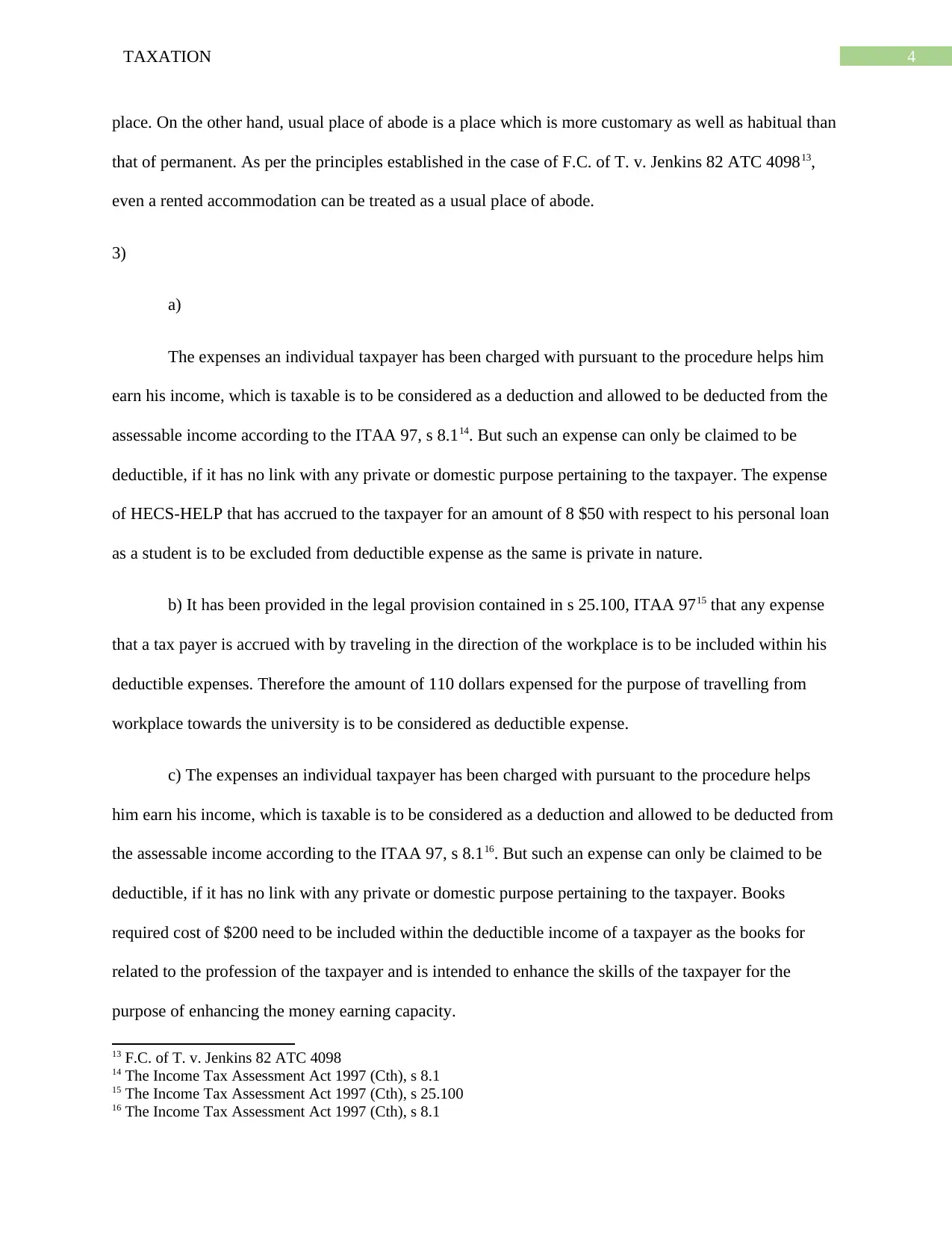
4TAXATION
place. On the other hand, usual place of abode is a place which is more customary as well as habitual than
that of permanent. As per the principles established in the case of F.C. of T. v. Jenkins 82 ATC 409813,
even a rented accommodation can be treated as a usual place of abode.
3)
a)
The expenses an individual taxpayer has been charged with pursuant to the procedure helps him
earn his income, which is taxable is to be considered as a deduction and allowed to be deducted from the
assessable income according to the ITAA 97, s 8.114. But such an expense can only be claimed to be
deductible, if it has no link with any private or domestic purpose pertaining to the taxpayer. The expense
of HECS-HELP that has accrued to the taxpayer for an amount of 8 $50 with respect to his personal loan
as a student is to be excluded from deductible expense as the same is private in nature.
b) It has been provided in the legal provision contained in s 25.100, ITAA 9715 that any expense
that a tax payer is accrued with by traveling in the direction of the workplace is to be included within his
deductible expenses. Therefore the amount of 110 dollars expensed for the purpose of travelling from
workplace towards the university is to be considered as deductible expense.
c) The expenses an individual taxpayer has been charged with pursuant to the procedure helps
him earn his income, which is taxable is to be considered as a deduction and allowed to be deducted from
the assessable income according to the ITAA 97, s 8.116. But such an expense can only be claimed to be
deductible, if it has no link with any private or domestic purpose pertaining to the taxpayer. Books
required cost of $200 need to be included within the deductible income of a taxpayer as the books for
related to the profession of the taxpayer and is intended to enhance the skills of the taxpayer for the
purpose of enhancing the money earning capacity.
13 F.C. of T. v. Jenkins 82 ATC 4098
14 The Income Tax Assessment Act 1997 (Cth), s 8.1
15 The Income Tax Assessment Act 1997 (Cth), s 25.100
16 The Income Tax Assessment Act 1997 (Cth), s 8.1
place. On the other hand, usual place of abode is a place which is more customary as well as habitual than
that of permanent. As per the principles established in the case of F.C. of T. v. Jenkins 82 ATC 409813,
even a rented accommodation can be treated as a usual place of abode.
3)
a)
The expenses an individual taxpayer has been charged with pursuant to the procedure helps him
earn his income, which is taxable is to be considered as a deduction and allowed to be deducted from the
assessable income according to the ITAA 97, s 8.114. But such an expense can only be claimed to be
deductible, if it has no link with any private or domestic purpose pertaining to the taxpayer. The expense
of HECS-HELP that has accrued to the taxpayer for an amount of 8 $50 with respect to his personal loan
as a student is to be excluded from deductible expense as the same is private in nature.
b) It has been provided in the legal provision contained in s 25.100, ITAA 9715 that any expense
that a tax payer is accrued with by traveling in the direction of the workplace is to be included within his
deductible expenses. Therefore the amount of 110 dollars expensed for the purpose of travelling from
workplace towards the university is to be considered as deductible expense.
c) The expenses an individual taxpayer has been charged with pursuant to the procedure helps
him earn his income, which is taxable is to be considered as a deduction and allowed to be deducted from
the assessable income according to the ITAA 97, s 8.116. But such an expense can only be claimed to be
deductible, if it has no link with any private or domestic purpose pertaining to the taxpayer. Books
required cost of $200 need to be included within the deductible income of a taxpayer as the books for
related to the profession of the taxpayer and is intended to enhance the skills of the taxpayer for the
purpose of enhancing the money earning capacity.
13 F.C. of T. v. Jenkins 82 ATC 4098
14 The Income Tax Assessment Act 1997 (Cth), s 8.1
15 The Income Tax Assessment Act 1997 (Cth), s 25.100
16 The Income Tax Assessment Act 1997 (Cth), s 8.1
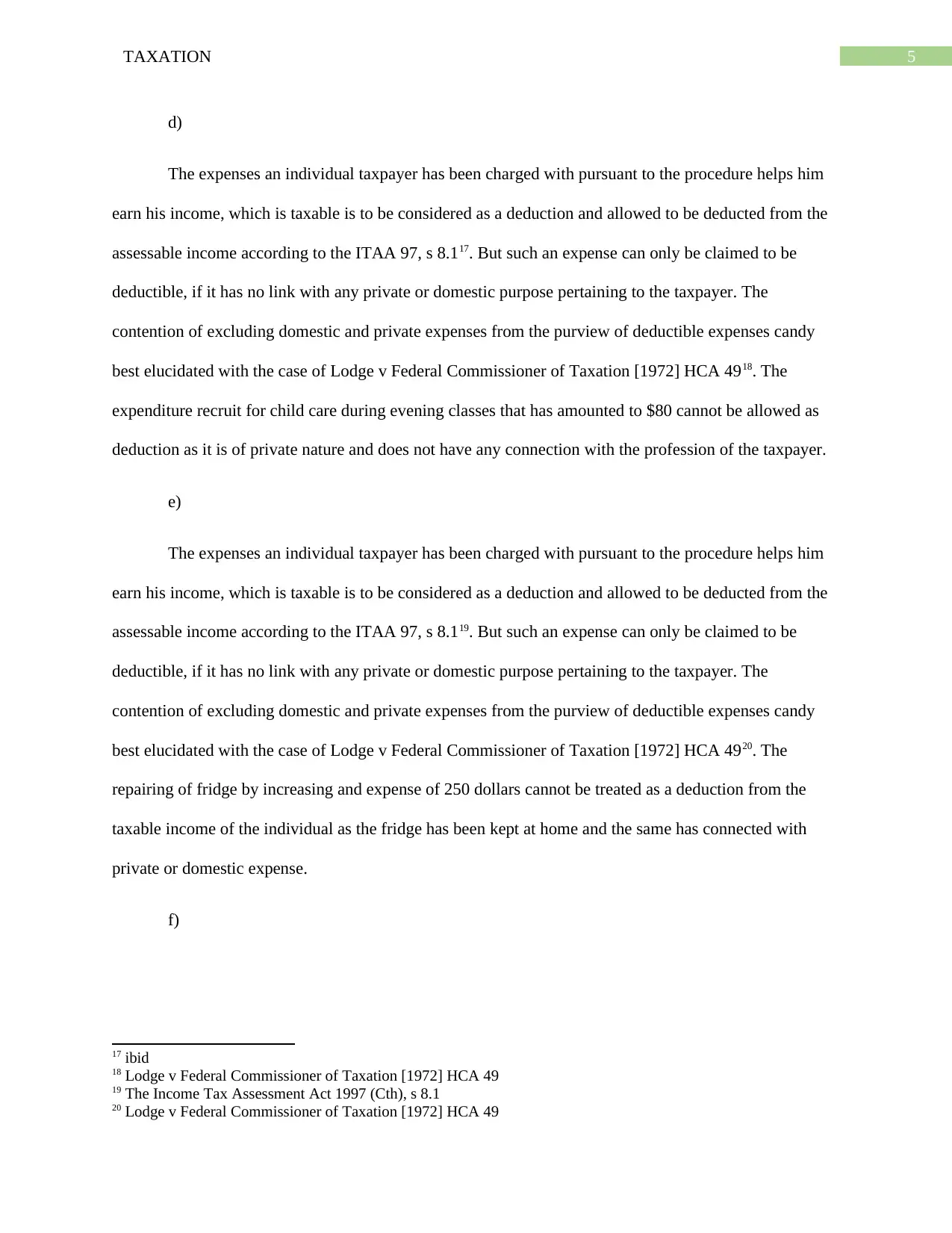
5TAXATION
d)
The expenses an individual taxpayer has been charged with pursuant to the procedure helps him
earn his income, which is taxable is to be considered as a deduction and allowed to be deducted from the
assessable income according to the ITAA 97, s 8.117. But such an expense can only be claimed to be
deductible, if it has no link with any private or domestic purpose pertaining to the taxpayer. The
contention of excluding domestic and private expenses from the purview of deductible expenses candy
best elucidated with the case of Lodge v Federal Commissioner of Taxation [1972] HCA 4918. The
expenditure recruit for child care during evening classes that has amounted to $80 cannot be allowed as
deduction as it is of private nature and does not have any connection with the profession of the taxpayer.
e)
The expenses an individual taxpayer has been charged with pursuant to the procedure helps him
earn his income, which is taxable is to be considered as a deduction and allowed to be deducted from the
assessable income according to the ITAA 97, s 8.119. But such an expense can only be claimed to be
deductible, if it has no link with any private or domestic purpose pertaining to the taxpayer. The
contention of excluding domestic and private expenses from the purview of deductible expenses candy
best elucidated with the case of Lodge v Federal Commissioner of Taxation [1972] HCA 4920. The
repairing of fridge by increasing and expense of 250 dollars cannot be treated as a deduction from the
taxable income of the individual as the fridge has been kept at home and the same has connected with
private or domestic expense.
f)
17 ibid
18 Lodge v Federal Commissioner of Taxation [1972] HCA 49
19 The Income Tax Assessment Act 1997 (Cth), s 8.1
20 Lodge v Federal Commissioner of Taxation [1972] HCA 49
d)
The expenses an individual taxpayer has been charged with pursuant to the procedure helps him
earn his income, which is taxable is to be considered as a deduction and allowed to be deducted from the
assessable income according to the ITAA 97, s 8.117. But such an expense can only be claimed to be
deductible, if it has no link with any private or domestic purpose pertaining to the taxpayer. The
contention of excluding domestic and private expenses from the purview of deductible expenses candy
best elucidated with the case of Lodge v Federal Commissioner of Taxation [1972] HCA 4918. The
expenditure recruit for child care during evening classes that has amounted to $80 cannot be allowed as
deduction as it is of private nature and does not have any connection with the profession of the taxpayer.
e)
The expenses an individual taxpayer has been charged with pursuant to the procedure helps him
earn his income, which is taxable is to be considered as a deduction and allowed to be deducted from the
assessable income according to the ITAA 97, s 8.119. But such an expense can only be claimed to be
deductible, if it has no link with any private or domestic purpose pertaining to the taxpayer. The
contention of excluding domestic and private expenses from the purview of deductible expenses candy
best elucidated with the case of Lodge v Federal Commissioner of Taxation [1972] HCA 4920. The
repairing of fridge by increasing and expense of 250 dollars cannot be treated as a deduction from the
taxable income of the individual as the fridge has been kept at home and the same has connected with
private or domestic expense.
f)
17 ibid
18 Lodge v Federal Commissioner of Taxation [1972] HCA 49
19 The Income Tax Assessment Act 1997 (Cth), s 8.1
20 Lodge v Federal Commissioner of Taxation [1972] HCA 49
You're viewing a preview
Unlock full access by subscribing today!
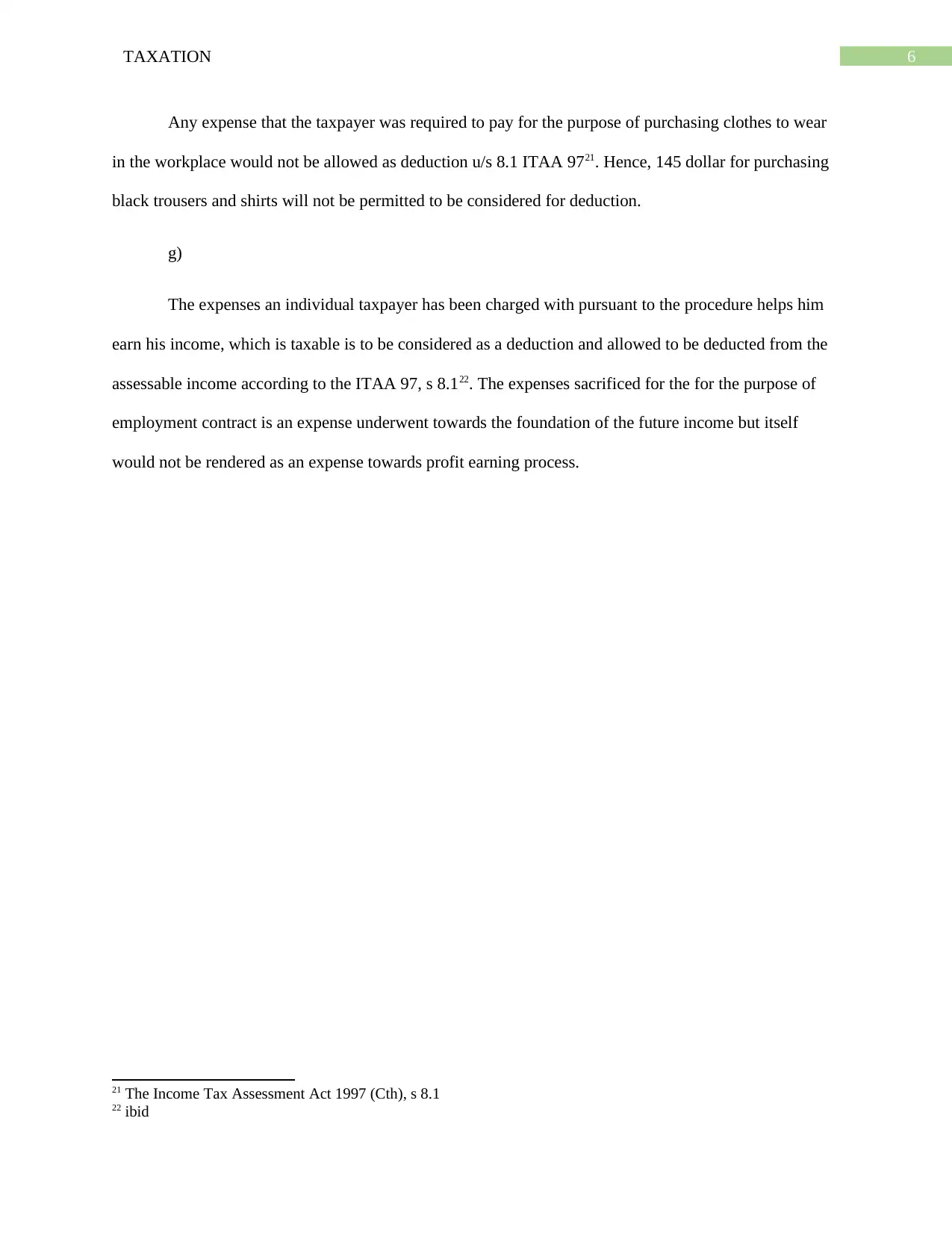
6TAXATION
Any expense that the taxpayer was required to pay for the purpose of purchasing clothes to wear
in the workplace would not be allowed as deduction u/s 8.1 ITAA 9721. Hence, 145 dollar for purchasing
black trousers and shirts will not be permitted to be considered for deduction.
g)
The expenses an individual taxpayer has been charged with pursuant to the procedure helps him
earn his income, which is taxable is to be considered as a deduction and allowed to be deducted from the
assessable income according to the ITAA 97, s 8.122. The expenses sacrificed for the for the purpose of
employment contract is an expense underwent towards the foundation of the future income but itself
would not be rendered as an expense towards profit earning process.
21 The Income Tax Assessment Act 1997 (Cth), s 8.1
22 ibid
Any expense that the taxpayer was required to pay for the purpose of purchasing clothes to wear
in the workplace would not be allowed as deduction u/s 8.1 ITAA 9721. Hence, 145 dollar for purchasing
black trousers and shirts will not be permitted to be considered for deduction.
g)
The expenses an individual taxpayer has been charged with pursuant to the procedure helps him
earn his income, which is taxable is to be considered as a deduction and allowed to be deducted from the
assessable income according to the ITAA 97, s 8.122. The expenses sacrificed for the for the purpose of
employment contract is an expense underwent towards the foundation of the future income but itself
would not be rendered as an expense towards profit earning process.
21 The Income Tax Assessment Act 1997 (Cth), s 8.1
22 ibid
Paraphrase This Document
Need a fresh take? Get an instant paraphrase of this document with our AI Paraphraser
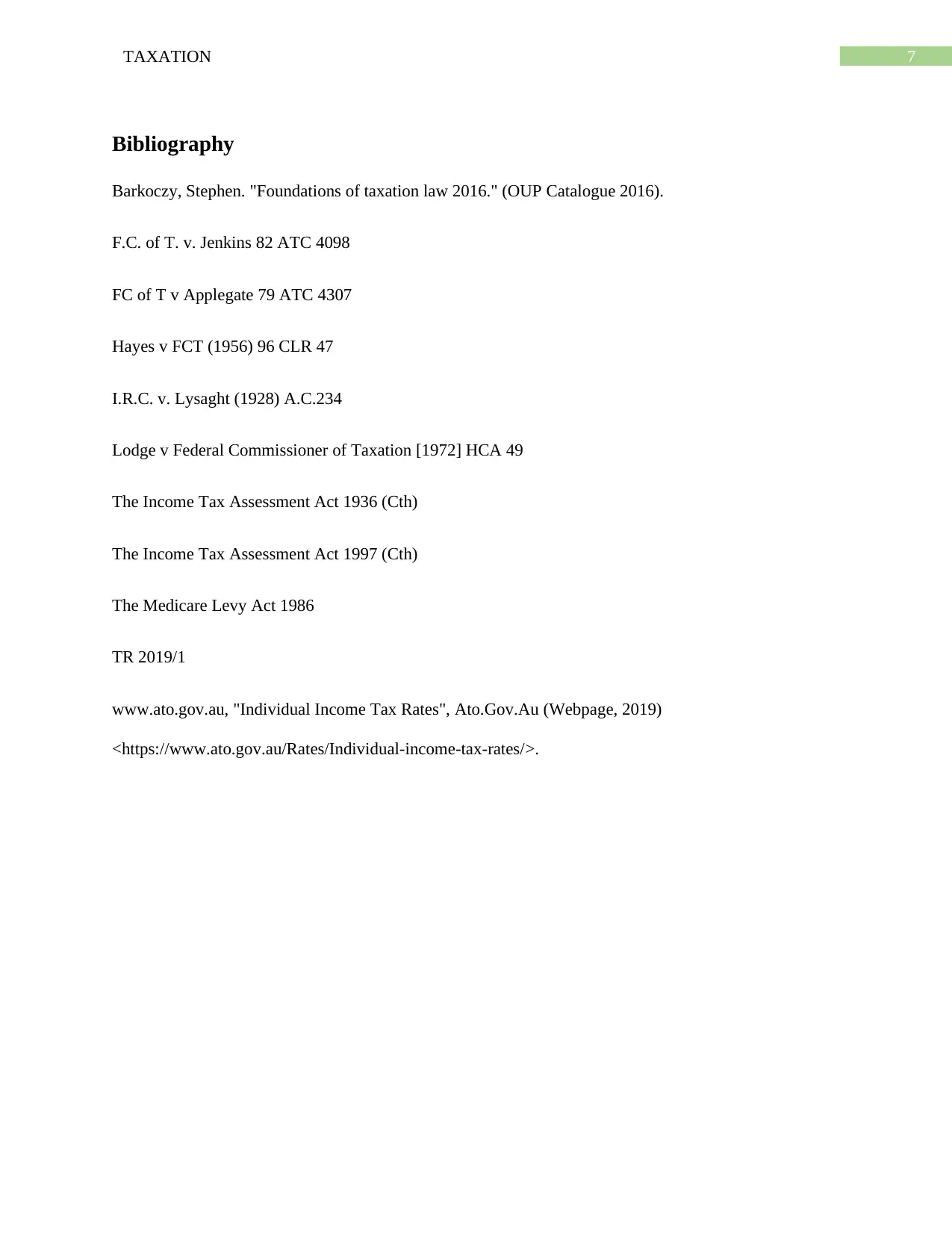
7TAXATION
Bibliography
Barkoczy, Stephen. "Foundations of taxation law 2016." (OUP Catalogue 2016).
F.C. of T. v. Jenkins 82 ATC 4098
FC of T v Applegate 79 ATC 4307
Hayes v FCT (1956) 96 CLR 47
I.R.C. v. Lysaght (1928) A.C.234
Lodge v Federal Commissioner of Taxation [1972] HCA 49
The Income Tax Assessment Act 1936 (Cth)
The Income Tax Assessment Act 1997 (Cth)
The Medicare Levy Act 1986
TR 2019/1
www.ato.gov.au, "Individual Income Tax Rates", Ato.Gov.Au (Webpage, 2019)
<https://www.ato.gov.au/Rates/Individual-income-tax-rates/>.
Bibliography
Barkoczy, Stephen. "Foundations of taxation law 2016." (OUP Catalogue 2016).
F.C. of T. v. Jenkins 82 ATC 4098
FC of T v Applegate 79 ATC 4307
Hayes v FCT (1956) 96 CLR 47
I.R.C. v. Lysaght (1928) A.C.234
Lodge v Federal Commissioner of Taxation [1972] HCA 49
The Income Tax Assessment Act 1936 (Cth)
The Income Tax Assessment Act 1997 (Cth)
The Medicare Levy Act 1986
TR 2019/1
www.ato.gov.au, "Individual Income Tax Rates", Ato.Gov.Au (Webpage, 2019)
<https://www.ato.gov.au/Rates/Individual-income-tax-rates/>.
1 out of 8
Related Documents
Your All-in-One AI-Powered Toolkit for Academic Success.
+13062052269
info@desklib.com
Available 24*7 on WhatsApp / Email
![[object Object]](/_next/static/media/star-bottom.7253800d.svg)
Unlock your academic potential
© 2024 | Zucol Services PVT LTD | All rights reserved.





